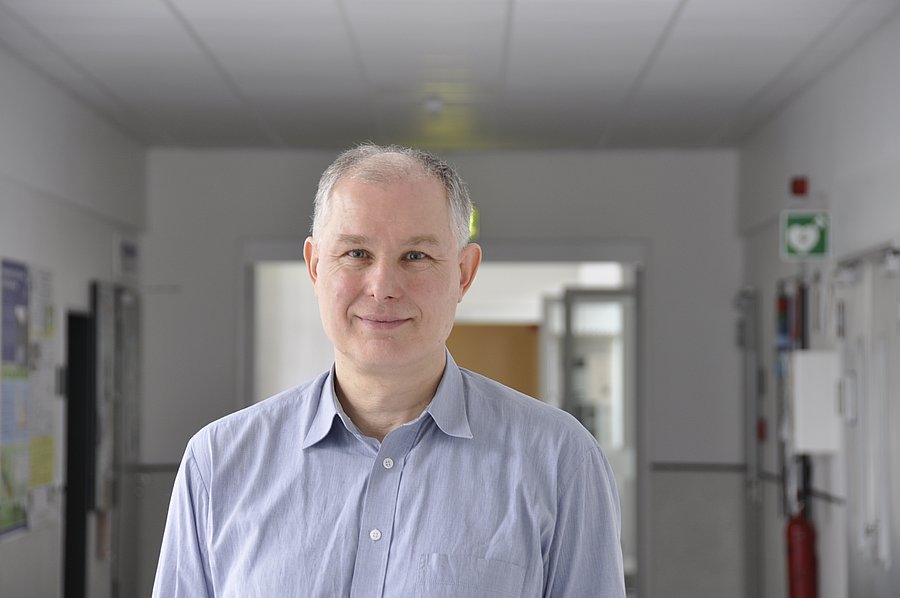
PFAS - misunderstood, concealed and highly toxic
Univ.-Prof. Prof. mult. Dr.-Ing. agr. Jörg Rinklebe / Soil and Groundwater Management
Photo: UniService Transfer
PFAS - misunderstood, concealed and highly toxic
Univ.-Prof. Prof. mult. Dr.-Ing. agr. Jörg Rinklebe on the dangers of the toxic poison PFAS for humans and the environment
Who doesn't love the breathable Gore-Tex jacket on the way to work, the quick coffee-to-go in the disposable cup and the crispy meat from the Teflon pan in the evening? Few people are aware that all these materials, which make everyday life easier, contain toxic substances that no one thinks about disposing of. We are talking about PFAS, perfluorinated alkyl substances, a group of industrial chemicals that are highly toxic to humans and the environment and are still being produced on a large scale because governments have underestimated the dangers for decades and have not adequately informed the public. Recent press reports are increasingly alarming citizens. Prof. Dr. Jörg Rinklebe, an environmental scientist from Wuppertal, is familiar with the dramatic effects of PFAS and calls for a fundamental change of direction by politics and industry.
At least 1500 locations in Germany affected
The highly toxic poison is found in at least 1500 places in Germany, is completely synthetically produced, does not exist in nature at all and is therefore difficult to recycle. "These substances are used in quite a variety of ways in our daily lives," Rinklebe explains. "They usually have many positive, for example, liquid-repellent properties, which is precisely why they are used in shoes, jackets and other clothing, but also in disposable tableware and in every to-go cup. These are toxic substances that are also incorporated into coatings on frying pans and in dental floss." Among other uses, the substance is also found in firefighting foams, which when used accordingly contaminate soil and groundwater. Rinklebe makes it unequivocally clear: "If PFAS gets into the human organism or the environment, it is very, very toxic. This group of substances is classified as priority hazardous both nationally and internationally."
Hazards have been known to expert scientists for decades
PFAS cannot be smelled, tasted or seen. It is believed to cause cancer, make you infertile and weaken your immune system. And once it gets into the environment, it stays there. And yet the public only now seems to really grasp what a powder keg we're on. "It's well known among experts," the scientist explains, "but people have tended to focus on the benefits of the substance and put up with the drawbacks. Then, over the years, only individual compounds were ever banned, or substitutes (replacement substances) were sought. This has led to the creation of similar substances that have the same de facto properties, but do not fall under the regulations, because they are then a new substance. So you have to at least control the whole group of substances and make sure it doesn't get into the environment and into people."
Authorities fail to educate
In many cases, authorities failed to inform the public at all. Rinklebe explains it this way: "Authorities always need a sound basis, a legal basis. To make matters worse, legal procedures take a long time. We don't calculate in years but in decades. Sometimes these processes take 10 or 20 years for such laws to come into force and, of course, production continues for that long, and harmful substances enter the environment, damaging people and ecosystems."
17000 locations affected across Europe - laws must be passed, now!
Here in NRW we are also affected. Cologne, Bonn, Düsseldorf and also Remscheid are marked on an interactive map. Across Europe, we are even talking about 17000 places, some of which pose considerable risks to people's health. We may have to struggle with the consequences for centuries to come. Although the problem has been known since the 1960s, there are still no binding rules in Germany that systematically limit the use and disposal of PFAS. The federal and state governments are hopelessly lagging behind in terms of legislation. "Only recently did the Federal Environment Agency recommend a guideline value," Rinklebe explains, immediately qualifying, "but a recommendation is still not a ban, which means it will be quite a while before a ban can come into force. As an example, I'll mention the so-called Mantelverordnung, which also includes the Federal Soil Protection and Contaminated Sites Ordinance, substitute building materials and the Groundwater Ordinance. This ordinance has taken more than 20 years and will hopefully finally be passed this year. We are happy about that, of course, but PFAS is not included in it at all yet. And we know that once a law or regulation is passed, it often takes another 20 years for such a new substance to be included." The expert therefore hopes for the possibility of a separate extra regulation, which he believes is very much called for in this case.
He also believes that more gas needs to be applied at the international level. "Recently, we published another commentary on this, where we point out that the EU must establish limit values as quickly as possible and can no longer talk itself out of banning only this or that small substance, because the industry immediately produces a similar substance, which is also toxic again. We basically have to legislate on that." At the same time, the PFAS sites found to date are only the lesser of two evils; a large number of areas have not even been recorded or investigated to date.
Remediation of PFAS-contaminated sites
"For sure, it will be a mammoth task to remediate this large number of PFAS-contaminated sites in the coming years, and unfortunately, common remediation methods are often inadequate," says Rinklebe, explaining, "That's why we are working on the development of new remediation technologies. In a research project funded by the LeitmarktAgenturNRW, the project sponsor ETN, the Forschungszentrum Jülich GmbH, the European Regional Development Fund (ERDF) and the state of NRW, we are developing a remediation process for such contaminated sites together with the company Intrapore."

Breathable outdoor jacket

To Go Becher

Teflon coated pan
Living the circular economy
The textile industry, metal finishing or waste paper processing companies specifically use PFAS. This raises the question of whether these companies can now dress warmly. Says Rinklebe: "They now have to actively look for other materials. Of course it's their business, we all participate in it, I also wear breathable clothing. We can all hardly escape it, although the disposable cups no longer have to be, each individual can contribute something for the environment. Even for firefighting foams, there are already good substitutes that have been developed, and they already work reasonably well. But for other things, like clothes, they're looking for alternatives that also take into account the disposal of those clothes, because that's also a huge problem." We remember, in 2018 China stopped importing our plastic waste, Germany was looking for alternatives. Recently, Economics Minister Robert Habeck traveled to Ghana, where our textile waste is dumped uncontrolled. These are German environmental problems that we exported to other countries and continents. "We in Germany and Europe are totally clean, because all our garbage goes somewhere else. But that's also where we have to start fundamentally," Rinklebe demands. "It has to be disposed of properly here, where we have the technologies, and detoxified if possible. We have to start living the circular economy. In an international comparison, Germany is not doing so badly as far as the circular economy is concerned; we are at about 49% and Africa is below 1%." But that shouldn't tempt us to pat ourselves on the back, as Rinklebe continues, "We're only less bad than the others because our goal should actually be 99% recycling. We should work on the circular economy, because there's still a lot to do. Germany has really been asleep in that direction for the last two decades."
Rinklebe organizes largest Bergische University conference in Wuppertal
The cleanup of known contaminated sites in Europe alone is estimated at 17 billion euros, according to a Northern Ireland study. The annual cost of treating people is even higher. German Environment Minister Steffi Lemke even says that PFAS remediation is almost impossible. Rinklebe is organizing an international conference in Wuppertal from September 06 to 10, which will also look at the issue of PFAS from all sides. "Our expert colleagues come from all areas of environmental research and human health research. Our conference is themed 'Clean Environment, Human Health, our Future`, which means protect human health, protect the environment, because that is our future." For the first time, leading expert scientists* from around the world are coming to this conference, which has never been held in Germany before and is being hosted in Wuppertal under Rinklebe's leadership. "We have more than 2000 registrations from 76 countries so far. The fields range from medical scientists studying harmful substances in the human body to experts studying harmful substances in polar bears, in whales and other large organisms down to the smallest organisms including nematodes and microorganisms. We welcome environmental scientists from all ecosystem areas, so professionals who study oceans and air, who study plants and soil, sediments and also the fresh water in rivers, lakes and groundwater. You can already say that in September the world's leading minds, the authoritative scientists are coming to Bergische Universität in Wuppertal."
The stone is already rolling, the conference will certainly accelerate it, and thereby hopefully achieve faster policy decisions for the population.
Uwe Blass
Univ.- Prof. mult. Dr.-Ing. agr. Jörg Rinklebe has been Professor of Soil and Groundwater Management at the University of Wuppertal since 2006. He is considered one of the most influential scientists in his field worldwide. His work is very frequently cited, which is why he was named a "Highly Cited Researcher." He is ranked 4th on the world ranking list for environmental sciences, with only a few German scientists ever listed among the top 100. From 1997 to 2006, he worked as a scientist, research associate and project leader in the Soil Research Section of the UFZ Environmental Research Centre Leipzig-Halle GmbH in Halle. He studied ecology for one year at the University of Edinburgh in Scotland (UK). At Martin Luther University in Halle-Wittenberg, he studied agriculture and specialized in soil science and plant nutrition
